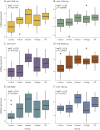MicroRNAs in CSF as prodromal biomarkers for Huntington disease in the PREDICT-HD study
- PMID: 29282329
- PMCID: PMC5798654
- DOI: 10.1212/WNL.0000000000004844
MicroRNAs in CSF as prodromal biomarkers for Huntington disease in the PREDICT-HD study
Abstract
Objective: To investigate the feasibility of microRNA (miRNA) levels in CSF as biomarkers for prodromal Huntington disease (HD).
Methods: miRNA levels were measured in CSF from 60 PREDICT-HD study participants using the HTG protocol. Using a CAG-Age Product score, 30 prodromal HD participants were selected based on estimated probability of imminent clinical diagnosis of HD (i.e., low, medium, high; n = 10/group). For comparison, participants already diagnosed (n = 15) and healthy controls (n = 15) were also selected.
Results: A total of 2,081 miRNAs were detected and 6 were significantly increased in the prodromal HD gene expansion carriers vs controls at false discovery rate q < 0.05 (miR-520f-3p, miR-135b-3p, miR-4317, miR-3928-5p, miR-8082, miR-140-5p). Evaluating the miRNA levels in each of the HD risk categories, all 6 revealed a pattern of increasing abundance from control to low risk, and from low risk to medium risk, which then leveled off from the medium to high risk and HD diagnosed groups.
Conclusions: This study reports miRNAs as CSF biomarkers of prodromal and diagnosed HD. Importantly, miRNAs were detected in the prodromal HD groups furthest from diagnosis where treatments are likely to be most consequential and meaningful. The identification of potential biomarkers in the disease prodrome may prove useful in evaluating treatments that may postpone disease onset.
Clinicaltrialsgov identifier: NCT00051324.
Copyright © 2017 The Author(s). Published by Wolters Kluwer Health, Inc. on behalf of the American Academy of Neurology.
Figures


Comment in
-
CSF microRNA in patients with Huntington disease.Neurology. 2018 Jan 23;90(4):151-152. doi: 10.1212/WNL.0000000000004871. Epub 2017 Dec 27. Neurology. 2018. PMID: 29282335 No abstract available.
References
-
- MacDonald ME, Ambrose CM, Duyao MP, et al. A novel gene containing a trinucleotide repeat that is expanded and unstable on Huntington's disease chromosomes. Cell 2016;72:971–983. - PubMed
-
- Gómez-Tortosa E, Macdonald ME, Friend JC, et al. Quantitative neuropathological changes in presymptomatic Huntington's disease. Ann Neurol 2001;49:29–34. - PubMed
-
- Vonsattel JP, Myers RH, Stevens TJ, Ferrante RJ, Bird ED, Richardson EP Jr. Neuropathological classification of Huntington's disease. J Neuropathol Exp Neurol 1985;44:559–577. - PubMed
-
- Aylward EH, Sparks BF, Field KM, et al. Onset and rate of striatal atrophy in preclinical Huntington disease. Neurology 2004;63:66–72. - PubMed
Publication types
MeSH terms
Substances
Associated data
Grants and funding
LinkOut - more resources
Full Text Sources
Other Literature Sources
Medical
Molecular Biology Databases
